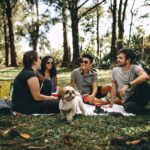Nearly one third of Australians are born overseas and an estimated 300 languages are spoken here. This make us one of the most culturally and linguistically diverse (CALD) nations in the world. Cultural diversity can bring challenges along the way – first and foremost communication in relation to disaster resilience.
During disasters time and information matter, so communication needs to cut through and be accessible to all. But with natural disasters on the rise and research showing low levels of disaster awareness and preparedness in CALD communities, these groups are increasingly at risk.
On top of language barriers, migrants, refugees and asylum seekers can face additional challenges. These include – being unfamiliar with their local environment, disaster risks, social structures and emergency procedures.
So how can we promote disaster preparedness and resilience for a nation with more than 300 languages?
Based on Australian Red Cross research* and our experience engaging with CALD communities here are the 5 top ways to assist in building disaster resilience:
1. Working directly with CALD communities
Local councils, emergency services and NGOs directly engaging CALD communities can build resilience skills, create connections within communities and improve community preparedness. Some councils employ people with a linguistically diverse background to help build trust and further connections with their communities. Others have created handbooks detailing how to appropriately engage and more effectively reach their local CALD communities.
2. Building knowledge inside CALD communities
Educational resilience programs and resources co-developed with CALD organisations can be highly effective. Inviting local emergency services representatives to discuss disaster risks and mitigations also helps. As many non-English speaking families rely on their children for translation and daily life information, school programs can be a great way to share information and resources. Service providers and places of worship can also be highly effective.
3. Removing information and language barriers
This is where culturally appropriate and linguistically diverse resources come in. By working with CALD communities, emergency services and councils can embed cultural considerations in emergency planning. This can be done by translating preparedness resources, sharing translated emergency warnings with CALD community leaders and providing interpreter services in evacuation centres.
4. Creating social capital
The more connected a community is, the better equipped it is to bounce back from a disaster. Strengthening relationships across different social groups by fostering participation in local events, volunteer programs and community meetings helps to build this resilience ahead of a disaster. Strong social networks definitely help when it comes to sharing information, coordinating volunteer efforts, creating community spirit and supporting each other post disaster.
5. Involving CALD communities as active partners
CALD community leaders have established relationships, are considered trusted sources of information and can communicate critical information in a culturally sensitive way. CALD organisations are well placed to help educate communities on preparedness, warn people in an emergency and help them recover.
Disaster resilience engagement in action: Coffs Harbour CALD Emergency Grapevine
The Grapevine is a community network made up of staff from St Vincent de Paul, Red Cross, Council, DCJ and the NSW Police who saw first-hand the effect of poor communication on the CALD community during multiple disasters. The Grapevine connects 22 distinct CALD community leaders with Easy English emergency warnings that are then shared through WhatsApp, which is the most common messaging platform used by local CALD communities.
Although communicating with CALD audiences can present challenges in a disaster, it can also offer amazing opportunities to strengthen our connections and relationships as a community.
* Chandonnet A (2021) ‘Emergency resilience in culturally and linguistically diverse communities: challenges and opportunities’, Australian Red Cross.






